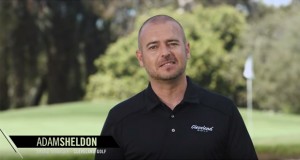Stan Utley is a former PGA Tour winner who has forged a remarkable second career as a teacher of the game. Based at Grayhawk Golf Club in Scottsdale, Arizona, Utley is today regarded as a short-game guru and one of the world’s top instructors. He is also the author of The Art of Putting and other titles, including the upcoming book The Art of The Swing (Gotham Books, May 2011). In this new book, Utley focuses on grip, stance and posture, ultimately revealing his “short-game sequencing secrets.” The book will also feature companion smartphone technology with corresponding on-demand video lessons. At PutterZone.com, we are longtime admirers of Utley’s methods and books, and were honored to recently speak with him about his upcoming title, as well as his thoughts on putting, putter fitting and more. Following is PutterZone.com’s exclusive Stan Utley interview:
Your previous books have focused on the short game. How far into the full swing does your new book go?
I have tipped over into the full swing with this book, but most of it is still about my short game principles. A lot of the principles that apply to short-game shots also apply to the full swing. The impact area is the same, the full swing is just bigger.
When it comes to what I’m looking for and what I share with players, one of the core things I want people to do is to hit a shot and ask, “Ball, what happened?” The ball tells us so much based on how it flies, as long as we know how to ask it the right questions.
If the ball goes to the right, the face is either open or the swing path was to the right or you aimed to the right. It’s one or two of those, or all three. When you ask the ball what you did wrong, it becomes a way to better self analyze and self correct. For example, in relating to sequence, if a person turns their body really hard early in the downswing and they leave their arms behind at the top, their arms are going to be late. And if the arms are late, most of the time the club face will be open.
Another example is that if a person swings their arms down really hard by pulling the grip, when the grip goes by the ball well before the club head, then the face is going to be open. Or let’s say, halfway down, the body stops and now the hands stop, and the club passes the hands real fast. Well, then the club face is going to be closed.
This book is pretty simple. I’m not an Xs and Os guy, I don’t say, “You have to be right here and your left wrist hast to be right there.” I’m going to say, as a teacher, and in this book, maybe not to get it all perfect. My aim is to inspire golfers to ask themselves better questions, and to do a better job self analyzing. Then maybe when they hit bad shots on holes four, five and six, they don’t try to fix themselves and get worse all day. They might actually play hole nine better. If you really just ask, “Ball, what happened,” and you have any clue whatsoever—is it face or path, is it steep or shallow, etcetera—all of a sudden you might help yourself. Most people “fix” themselves by compounding the error, I see it at pro-ams all the time.
You have said, “It’s okay to use your hands, wrists and forearms when making a golf shot. Too many people try to eliminate those from their swing, to their detriment.” Does that hold for the putting stroke as well?
Yes. I do not believe my stroke looks wristy. I do not believe Brad Faxon’s stroke looks wristy. Yet I think most people, if they stepped inside of our strokes, they would think it felt very wristy. With students, I don’t want them to go away and look wristy. But most people who are bad at putting—and for sure if they show up and say they can’t lag putt—are wristy backwards.
That means that they shove the grip back and don’t move the head. After they do that, they shove the handle forward because they didn’t create any momentum in the back swing. There’s no swing to the club head, they’ve just carried the club head to the right, now they shove the grip forward, so there’s still no momentum on the club head. And then, after they’ve already hit the ball with no momentum, they flip their wrist. So their friends all say, “You’re wristy.” But they’re only wristy at the end, after the ball is gone and they didn’t hit it very well.
So yes I make the person feel wristy, but no, I don’t want them to look wristy. And they have to become aware of their hands, wrist and forearms to get it right.
Another leading instructor once told PutterZone.com that he would prefer his students to imagine their hands in a block of cement, that’s how quiet he wanted the small muscles.
You know what? I’ll bet his students do well. There’s just so many different ways to get it done. He’s probably going to help a bunch of students, and there’s probably going to be a handful of guys he tried to help who come see me, and I’m going to help a lot of students, and some of my guys are going to go need to see him. And that’s cool, it makes the world go around.
In the end, I’ll tell you this. I’ll bet he and I both like the same strokes. That’s the tricky part. People ask me all the time now about Dave Stockton, and I think, “I haven’t taken a lesson from Dave.” If my puttng sucked, I would probably go see him because he’s a great putter. Don’t go take a lesson from a guy who can’t putt. Go see somebody who makes putts that matter! And I’ll bet that with setup, backswing and impact, Dave and I like a lot of the same stuff. I think after you hit the ball, what he’s asking people to do is a little different than what I ask, but you know what, I think he would like my stroke if he saw it, and I’ll bet I would like his stroke. But we tell it differently. We tell what we feel, what we’ve learned.
My message goes back to 1982, when my mentor gave me a lesson, and I still reference that. I never want to come across as saying, “This is it, this is the only way.” But if you tell a guy that his hands need to be in a block of cement, he’d better know what that means. He’d better have some kind of recognition of his hands and wrists in order to do that. I’m making my student aware of what the hands and wrists do. Whether you want to use them less or more or not at all, you’d better know what they’re doing, you’d better be aware. And the ball tells you a lot if you know what to ask it.
In The Art of Putting, you wrote that “the putting stroke is a smaller version of the full swing.” Tiger Woods said the same thing recently. Yet a lot of people are taught to take the putter straight back and straight through. Can you elaborate on that?
A good friend of mine, Rob Akins, teaches David Toms and others, and he’s a highly reputable teacher, and he made the greatest comment. He said that what I teach is “a straight back, straight through, square-to-square putting stroke, on the swing plane.”
So what that means is, in golf, most instructors want you to swing the club on the plane of the shaft. So if the shaft were vertical and you swung on plane, the putter head would go straight up and down the target line, and the face would stay square to that line. But in golf, we stand off to the side of the ball. And when the shaft is on a tilt, and I swing the club on plane, as it goes back, it’s going to creep off to the inside a little bit because it’s a tilted circle, and all I want the face to do is to stay square to the path. So that’s square-to square-putting on a tilted circle, not a vertical circle. That’s my message.
My new book is about sequencing. So in putting, as you go up and away from the putter head—in other words, as you move up the shaft into your hands, the grip, your elbows, body and shoulders—things should move less. You will see a really bad putter moving his shoulder and his head as much as the putter head, and that’s inefficient. My shoulders are five and a half feet away from the putter head, so they shouldn’t move as much as the putter head. That’s me in a nutshell. I’ve just told you everything I look for in putting.
That’s the reason I got excited about this book. I believe that as I’ve developed as a teacher, I see the sequence. I see the part that’s moving out of order, and I help the student understand what that means and what it feels like to get it back in sequence.
You worked with Sergio Garcia in the past. It seems like he might be getting his groove back?
Sergio was dead-on with the putter in 2008, he was perfect. But I haven’t really given him a lesson since early 2009. The rest of 2009, I was around, but he was never in a mood for a lesson. I just told him, “Until you get happy, there’s no point in teaching you, but I’ll hang out with you.” I think he loved that, I wasn’t trying to fix his personal life, all I did was try to care for him. But I saw Sergio at Augusta, he came over and gave me a big high five. He went out of his way to say hello with a big ol’ grin. He’s a good dude. I appreciate that he treats me like a friend, not like some coach who didn’t work out, and I respect him for that a lot. I cheer for him. It’s so much less about his golf game than it is about his personal life, and I think it’s getting better, and he’s going to play better.
Putter fitting is a hot topic. What are your thoughts on it as it relates to the average recreational golfer?
I do think putter fitting matters, just like wedge fitting matters. The problem I see is sometimes a guy goes to the shop and the putter fits him perfectly, and that’s cool. But sometimes it’s too upright. So he either uses the putter and the toe is way in the air, which affects aim, and occasionally the heel hits the ground first and he flips the toe closed and pulls the putt. Or sometimes he adjusts his body position so that the putter sits correctly. And I would simply say that’s backwards. I don’t want the player to fit themselves to the instrument, I want the instrument fit to the player.
Now, all that being said, I keep it pretty simple. You determine how long the putter should be based on the player’s good setup. From there I’m mostly interested in lie angle and loft. I’m friends with David Edel, he’s got a whole system that helps a person aim. I don’t know all of those rules, so I’ll pass that on to him. But I know that I like a putter that’s attractive. There are a lot of putters out there that are so complicated when you look down. They are meant to help with aiming, but I think they’re worse. My buddies with SAM PuttLab did a lot of research on aiming, and the old Acushnet Bull’s-Eye was the best-aiming putter. Take that to the bank. The least-complicated putter of all was the easiest one to aim. It didn’t even have a line on it.
So that has something to do with it. But I’m very particular on wanting the putter to sit flat when the student is in a good setup—and by good setup, I mean something fundamental and structural, and something he can feel comfortable in and repeat. And then I pay attention to loft, because I do not want the shaft to lean back at impact. I want the shaft vertical or slightly forward-pressed at impact. If a student shows up and his putter has no loft on it—let’s say zero to two degrees—and he sets up to the ball with his hands behind the face, that’s what his eye likes to see the face look like. I’ll just bend the putter so that the hands can go back to neutral, not behind the ball. I’ll put putters at four to five degrees of loft, not two degrees. At impact, with my hands forward when I hit it, even though my putter’s at five degrees, I’m hitting the ball at two to three degrees of (dynamic) loft at impact. But I don’t want to have to flip the head to get those two degrees of loft at impact. I want my hands to lead the face a degree or two.
Thanks, Stan! Look for The Art of The Swing to hit the shelves in early May. Visit StanUtley.com for updates. Also, check out the SeeItGolf app to experience audio training from Stan Utley.
 PutterZone – Best Putter Reviews
PutterZone – Best Putter Reviews




Nice interview. I'm really interested in what Stan was saying about the sequence, it will make me study my back swing some more in both the swing and putts.
Thanks
That was a great read. I've been thinking about picking up his books for a while now and this just clinched it for me. Thanks for a great article.
I never write reviews but I couldn't miss the chance to write the first review of this book. I am a big fan of Stan Utley, and while I have read all of his books, at times I have had some difficulty getting the feel of his short game swing instruction and had to make the leap of executing what I thought he meant. Sometimes I didn't get it right, so I end up reading Phil's hinge and hold or Tom Watson's short game book.